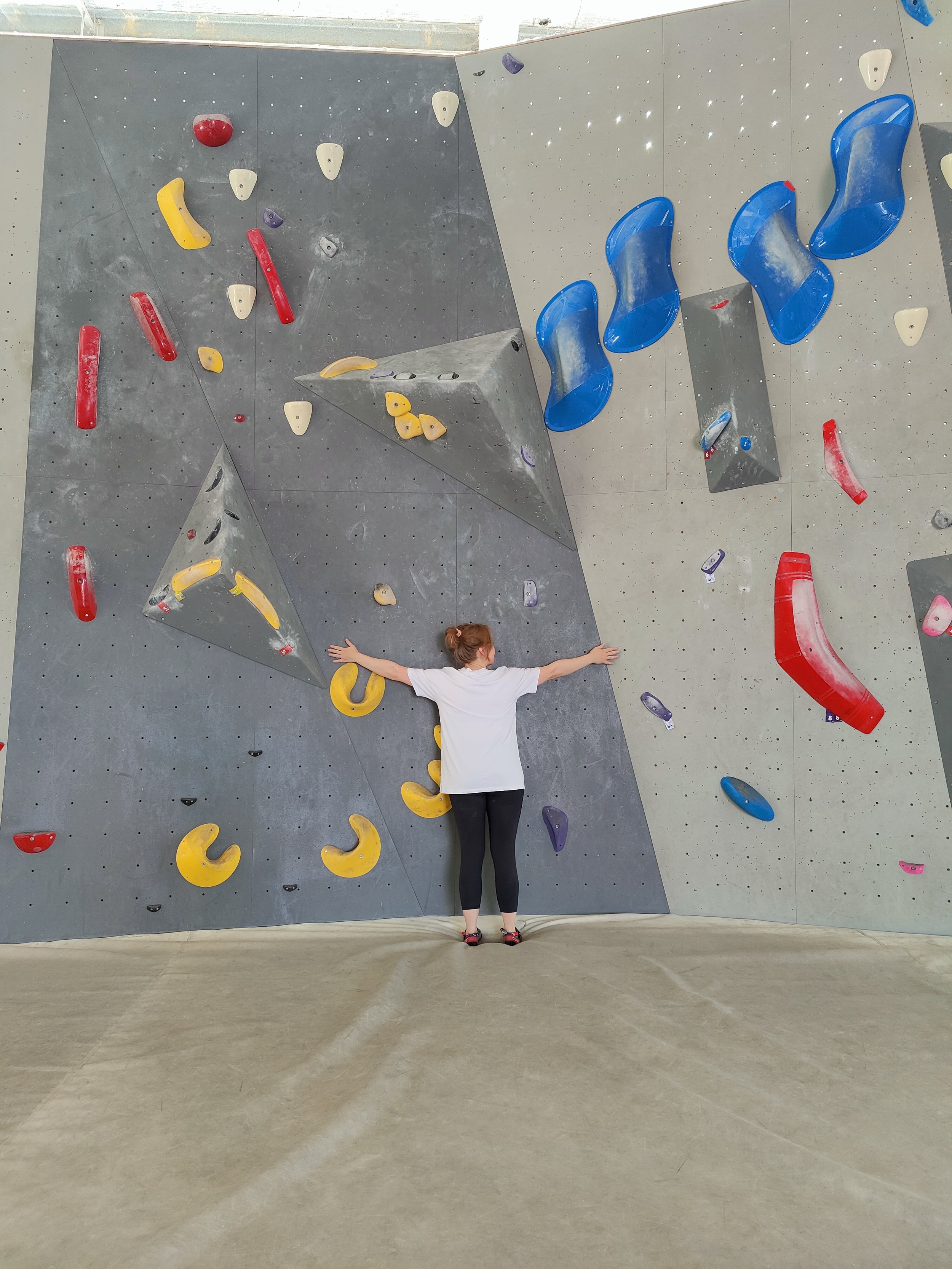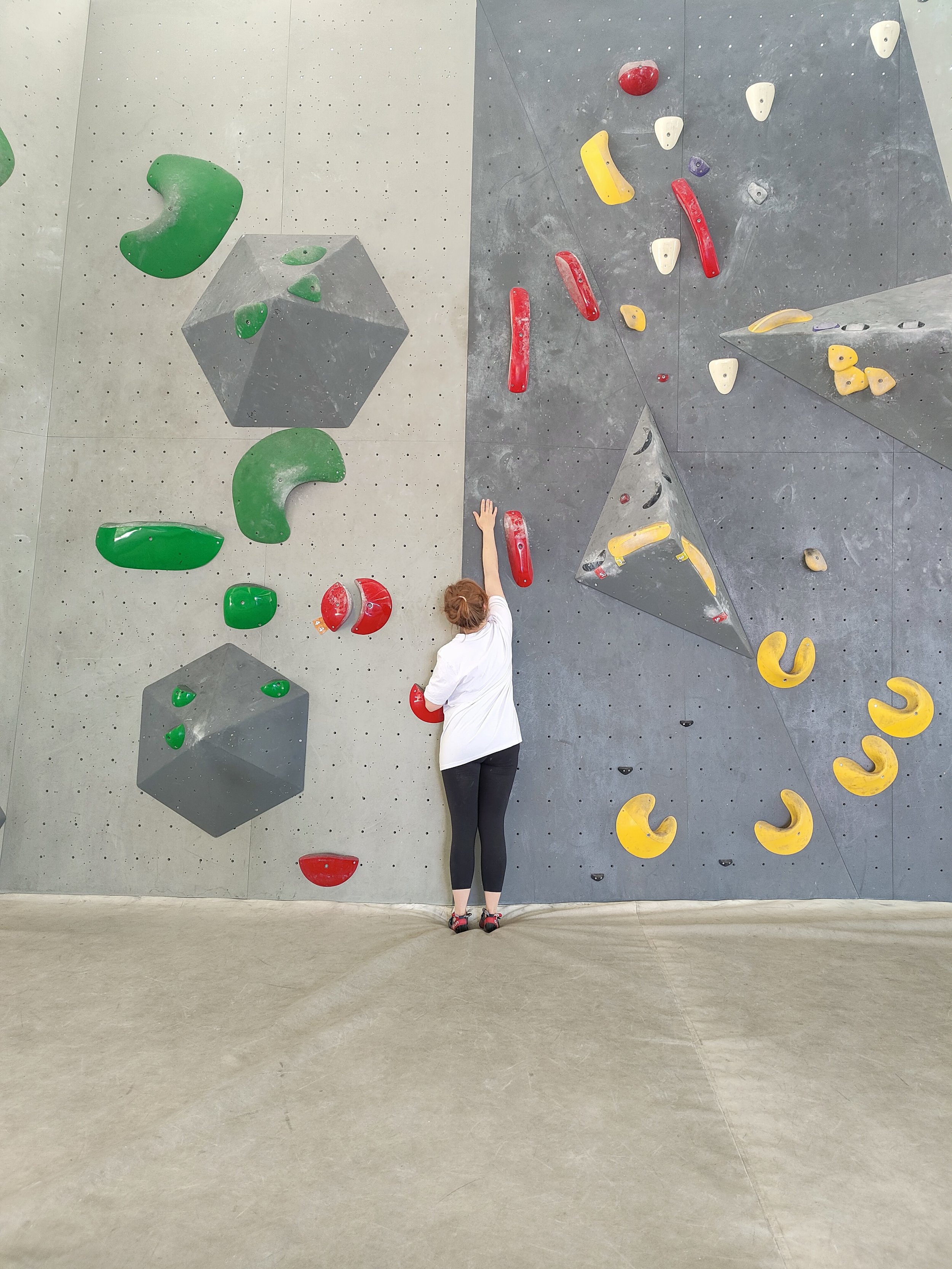Shorty Beta Project Part 4/4 - Creative Movement if you’re short.
Over the course of this blog series we have covered mindset, mobility, strength, dynamics and now let’s tie these all together with creative on the wall movement and beta tips!
1) Route-Reading.
Helpful not just if you’re short. The more you can plan how you’re going to move and where the challenging areas are the more efficiently you will climb. I often see climbers jumping on a problem and working out as they go (I have been guilty of this especially on my warm-up climbs!). However when you route-read a few things will happen
less attempts needed = energy & skin conserved! You will need it especially if you are needing to adopt a more dynamic style being shorter (more tiring on the body and not as skin friendly unfortunately). You will spend a shorter amount of time on the wall as you won’t be needing to work out a move mid route/ problem.
often will be moving more efficiently and sharing the loads well across the body rather than getting yourself into an odd predicament halfway up a route/ boulder problem. Less likely to overload 1 specific body part and you will begin to better understand how your body moves best. Start with planning 1-2 moves ahead, then 3-4 and so on. When you get down re-assess if your planned beta was actually how you climbed
(tip: film yourself climbing, easiest done when bouldering. You can then establish if a move is truly out of reach or perhaps if you need to change up your beta, work on certain areas of strength or maybe it’s a commitment thing, can you say that you truly went for it?)
2) Know your reach!
Knowing where the reachier moves will be that you will need to problem solve around with creative beta or mentally prepare to dyno it (if you are a climber that is not dynamically inclined)!
A great tip I learnt from a wonderful climbing coach was to know your reach in the number of bolt holes for your wingspan and your reach overhead (see photos below on how-to).
You can measure this best on slab/ flat walls in a gym, works best if there are no holds/ volumes sticking out that will force your hips away from the wall so you can get an accurate reading! See my measurements positions below!
1) Your Wingspan from fingertip to fingertip (mines about 11.75 bolt holes) - on left
2) Your Overhead reach from standing (mines roughly 13ish from softer matting) - on right
3) Hitting holds in an open position to get that extra bit of reach
You can get those extra few cm’s of reach by not only hitting the next hold in an open position but also readjusting your trailing hand into an open grip position. More often than not when you arrive at the hold you will need to adjust your grip accordingly (hence the active hang finger training being helpful - see Part 2 of the series on how-to).
I often find that shorter climbers will naturally be quite strong here in an open hand/ 3 finger drag grip as they have instinctively adopted this strategy! It is helpful to train all grip types however this tip can come in handy if something is just out of reach.
I am hitting the right hold in a 3 finger drag before re-adjusting by bringing the hips across and right foot to complete the next move
4) Intermediate holds, drop knees & flagging
As a shorter climber you may need to sprinkle in some intermediate holds that you can use whether it be a tiny foot hold, a little crimp somewhere or any other hold really (easier to do on real rock/ a spray wall vs set climbs). At times I’ve even used foot holds, can be tricky though they’re not too friendly to hold on to.
This will allow you to break up longer moves into 2-3 parts. It will look different to your tall friend’s beta but that’s ok as you are finding what works best for your body. More often than not it will involve getting your feet higher or analysing the holds/ rock closely for things other climbers may not even have used.
And you never know that tiny crimp you found might feet perfectly good for your little hands!
Flagging comes in handy to maintain tension when you hit a move at your span (picture on left) when used actively, and a drop knee enables you to twist and reach that bit farther. At times you may simply need to smear if you can’t find another option for feet within reach. Style points for the most creative solution here!
5) Dynamic Movement Accuracy
As a shorter climber you will find yourself needing to move dynamically more often especially as you progress through grades and the boulder problems/ routes become more challenging.
The room for error will also be much smaller if you are hitting a hold already at your span and in an open hand position. Therefore doing mini drills often for practising your dynamics on the long moves is key to understand your body positioning better and improve your timing & co-ordination for moves in all directions and on different wall angles.
An important area for training off the wall here is contact strength (see Part 2 of the series for exercises and Part 3 on what is power!), which is the ability to produce high amounts of force in a short amount of time. Boulderers often will be able to produce those high forces earlier vs route climbers due to the nature of the discipline, however as with anything there are always exceptions! Once you train to build the ability to apply force quickly off the wall you can practice directing it better and piecing it all together on the wall.
Here I am preparing for a dynamic step up into the next move, I got my right foot as high as I could on the volume so the distance isn’t as fat, and standing on my toes on my left. The hold I was going for was a jug so there was a little bit more room for error when you are learning these movements!
___________________________
Now that wraps it up for the Shorty Beta Project series! I hope that this has armed you with some tools you can use to better direct your training on and off the wall.
To get the most out of these tips put them into action try 1 or 2 things every other session and mix it in with your regular climbing that you enjoy! It can be tricky to always work on things that are challenging so don’t forget to also climb the problems and routes you love that feel good whilst working on some of these things in the background. It will take time but it will be worth it and so much more climbing will open up to you!







